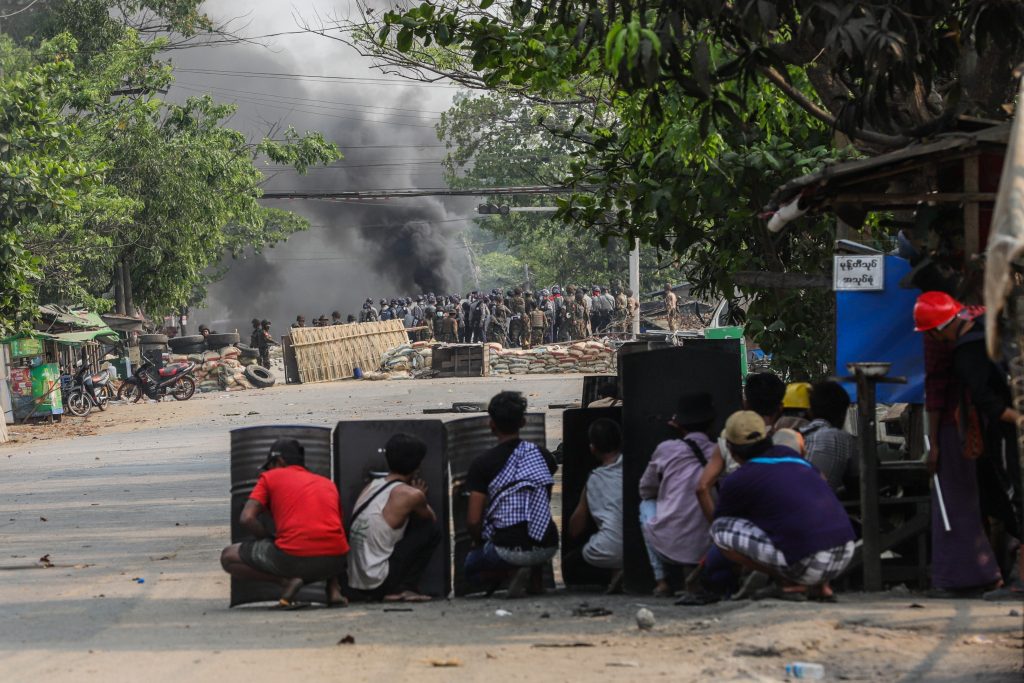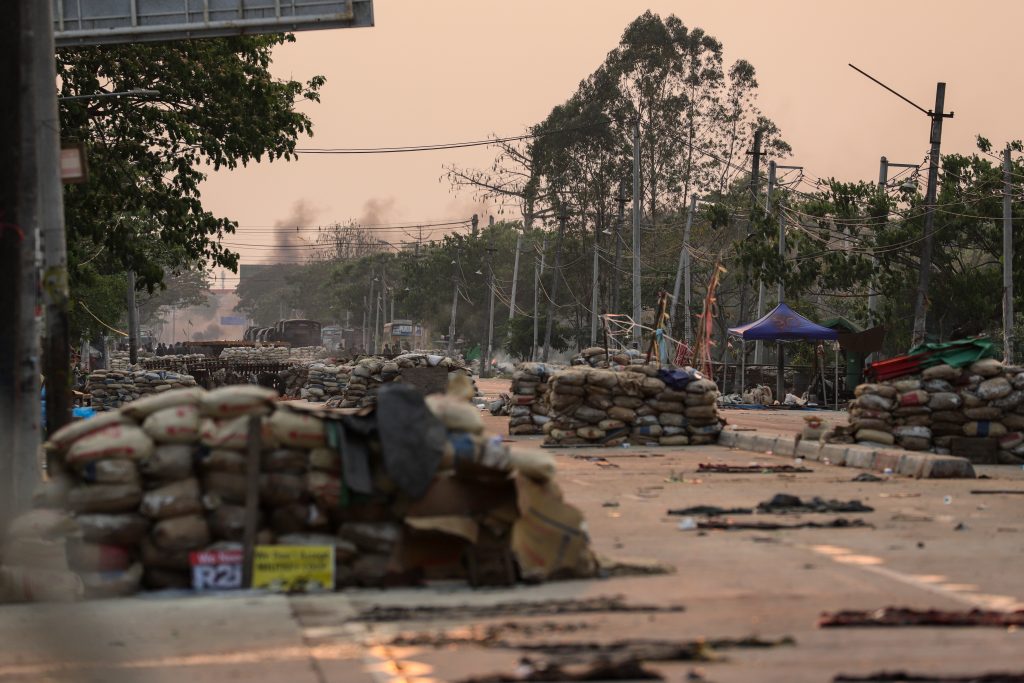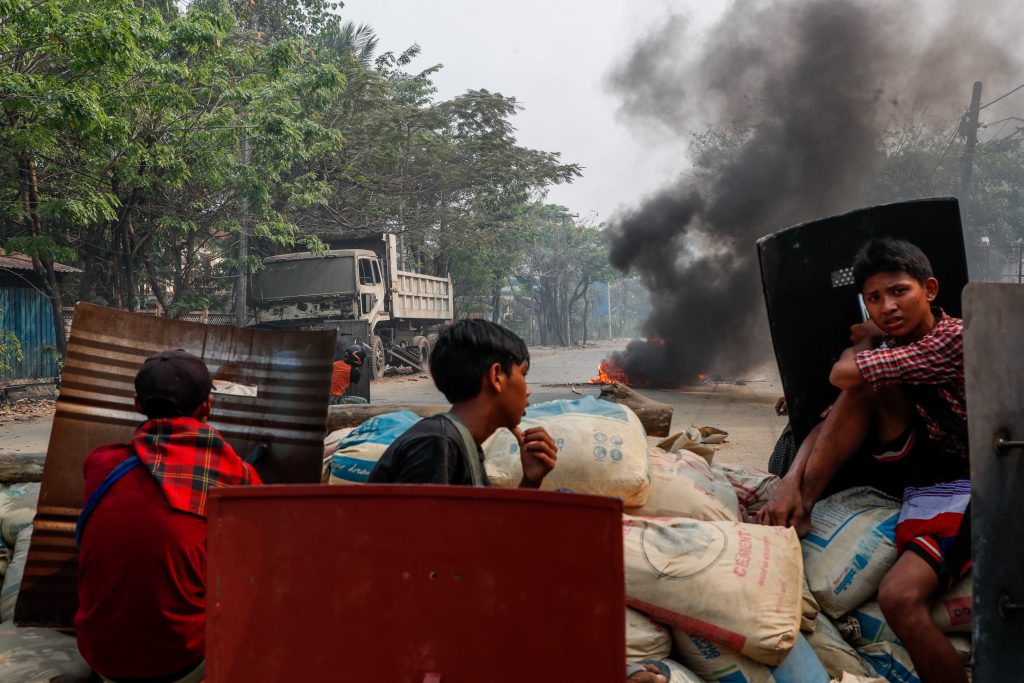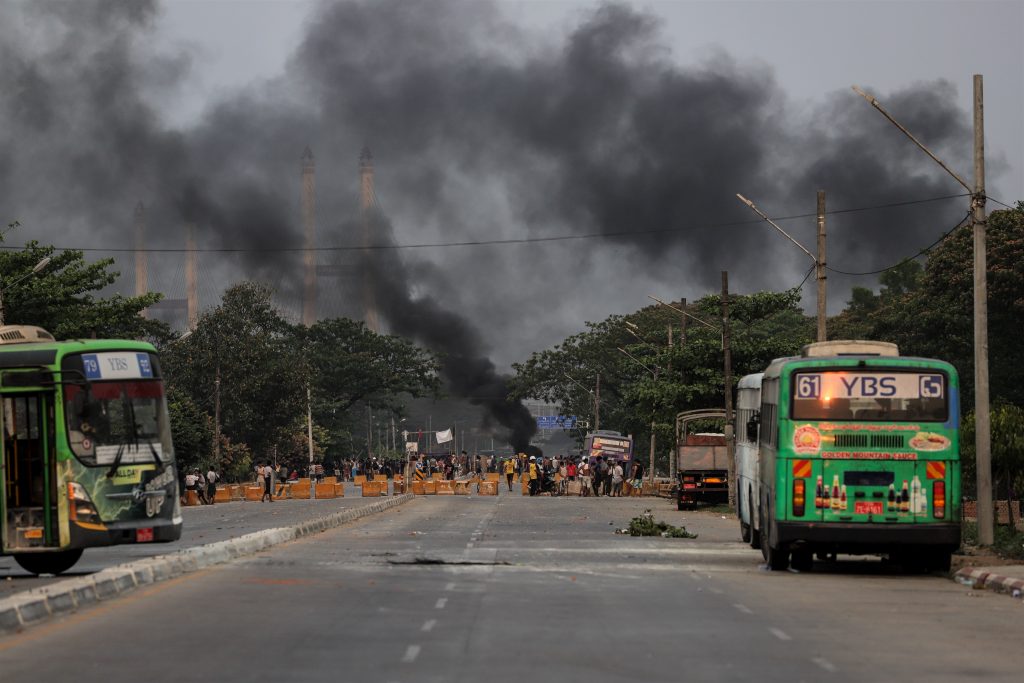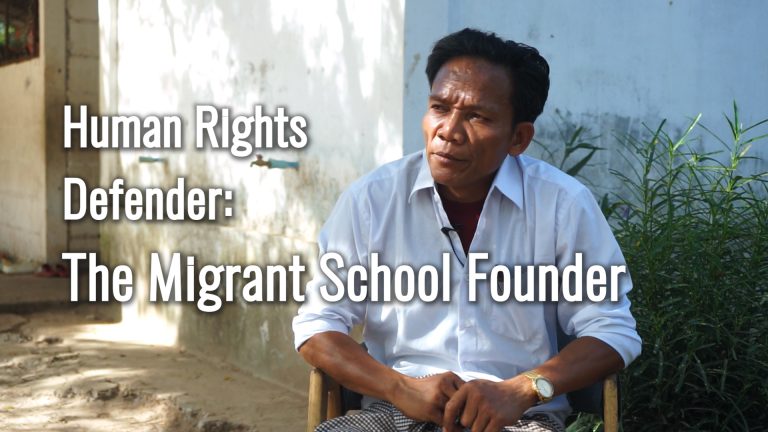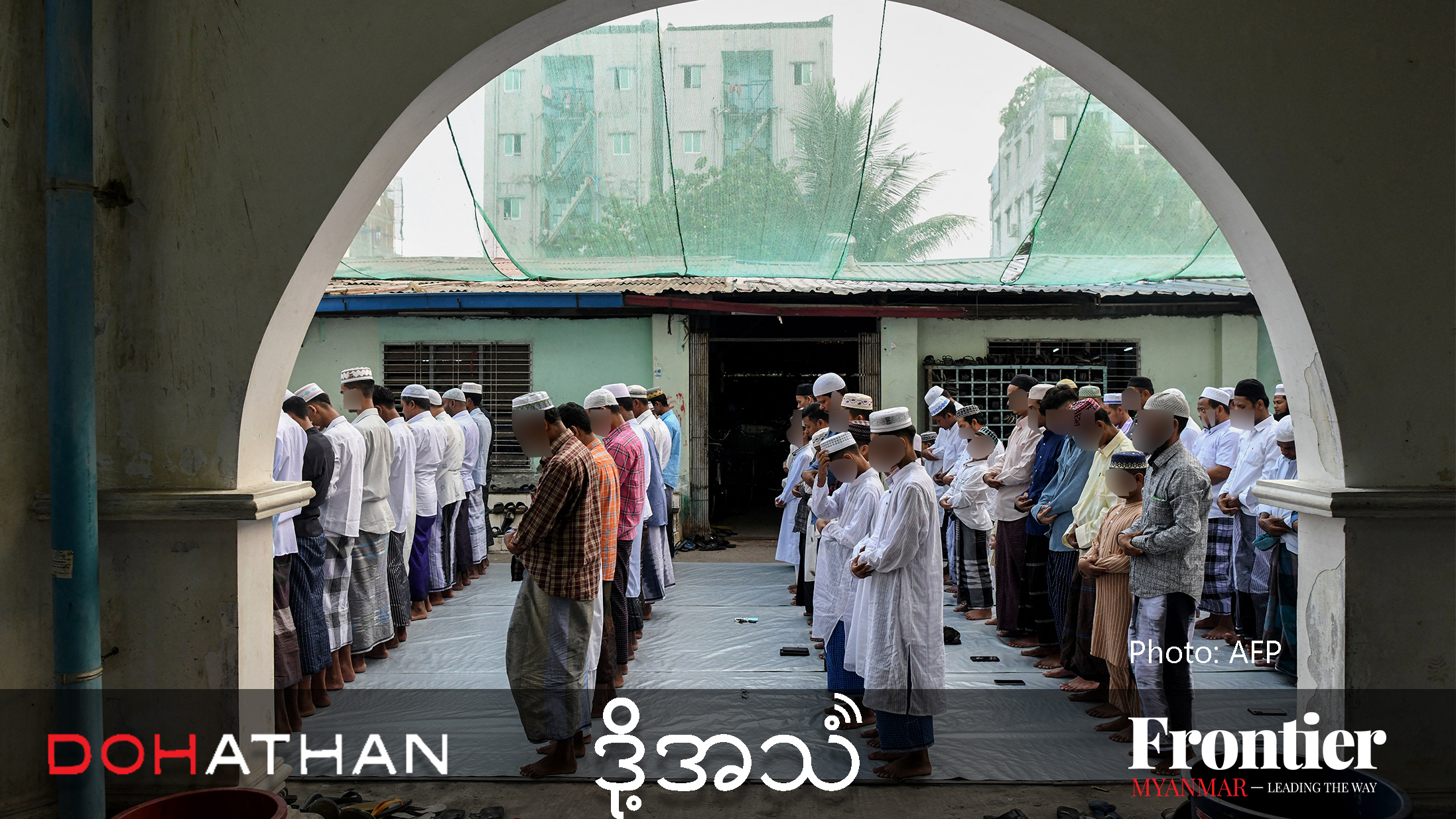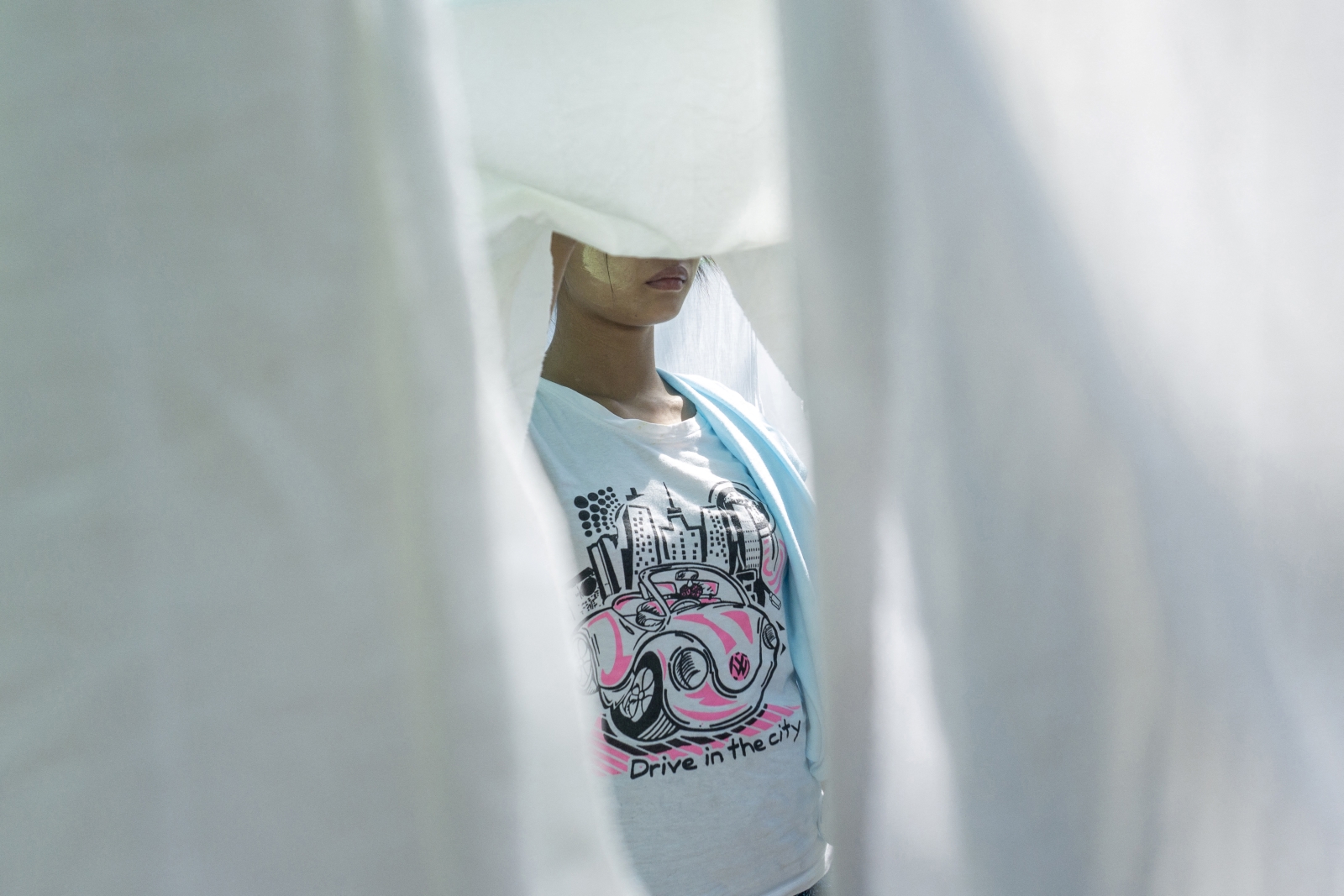A Frontier photographer reports on a terrifying and deadly day in the western Yangon township, when dozens of pro-democracy protesters were killed on March 14.
By FRONTIER
Just after 6am on March 14, I watched monks and laypeople shuffle through the last remains of overnight fog to cross Hlaing River Road, in Yangon’s Hlaing Tharyar Township.
Behind them was a large barricade made of bamboo sheets and bags of cement, above which a red vinyl sign read: “If the blood of one Hlaing Tharyar resident hits the ground, one Chinese factory must burn.”
The protest camp was still empty, but around 7am a group of about 50 women arrived and began chanting pahtan, a Buddhist prayer for safety and good fortune.
It was a calm start to what would become a deadly day – one in which dozens of pro-democracy demonstrators would end up dead at the hands of the security forces.
I had only decided to come to Hlaing Tharyar the day before, after seeing photos of the large barricades and huge protests staged there on Facebook. Not wanting to go alone, I checked with some photographer friends, who agreed to join me.
We’d set out early to avoid traffic, crossing the Hlaing River at the Aung Zayar Bridge – the middle of the three bridges linking central Yangon and the industrial suburb of Hlaing Tharyar – shortly after dawn. We had no idea the next 24 hours would see us shot at, tear gassed, threatened by protesters, and forced to run for our lives, sneaking from one building to the next.
For now, though, the protest camp was still quiet, so we tried to grab some extra sleep in the car, which we’d parked on a side road. After about an hour, we were woken suddenly by the sound of someone tapping on the window. About 10 protesters had surrounded our car; when we opened the door, they asked why we were there and what we were doing. We said we were photojournalists, and explained apologetically that we were waiting for the protests to start.
They said that because our car was green and had black tinted windows, they had thought we were from the military. Although they were more curious than aggressive, we didn’t want to attract any more attention so we waited outside for the protests to begin.
Around 9:30am a large group had gathered at the protest camp, some of them carrying makeshift shields. When I tried to walk up to the camp on Hlaing River Road (also known as Nyaungdon Road) from the side street, a security guard stopped me, asking which media organisation I was from. Even after I explained, he continued to eye me with suspicion, but when I showed my press card he finally he let me proceed.
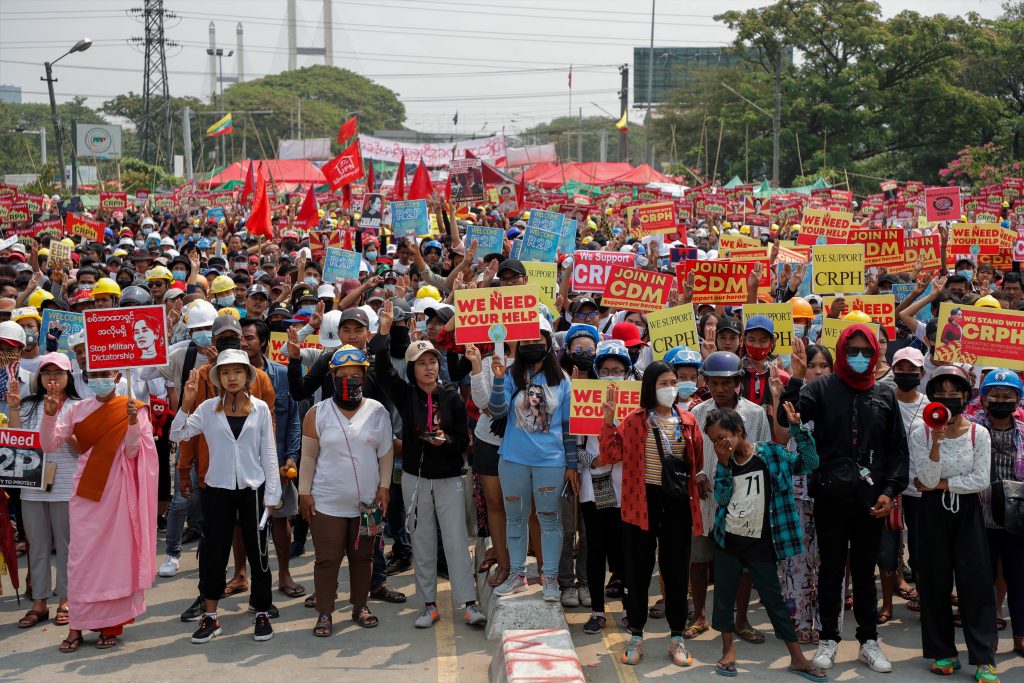
Demonstrators gather in Hlaing Tharyar. (Frontier) 
Frontline protesters raise three-finger salutes behind homemade shields. (Frontier)
By 10:30am, thousands of protesters had gathered in the centre of the camp and were shouting protest slogans. Shortly after, photos began circulating on Facebook showing military trucks crossing the Bayintnaung Bridge from central Yangon to Hlaing Tharyar further to the south. The news spread quickly through the crowd, and despite the clear danger and likelihood of bloodshed, the mood was defiant. A person with a loud speaker said to the protesters: “We could face a crackdown today, but are you afraid, Hlaing Tharyar people?”
“We are not afraid! We are not afraid!” the crowd yelled in unison, and began chanting revolutionary songs.
By this point, the camp stretched from the Htate 1 bus stop just down from the Aung Zaya Bridge to the Htate 3 stop, about 300 metres to the west. In the middle of the crowd was Htate 2.
In front of Htate 1, facing the bridge, were a group of hardcore-looking men who seemed determined to protect Hlaing Tharyar from invading forces. I could see a black flag flying, and a man standing on top of the Htate 1 barricade with his swords crossed. I decided to move up to them and try to take photos.
Suddenly, the previously orderly protest turned to chaos. The security forces who had crossed Bayintnaung Bridge must have headed west and then doubled back along Hlaing River Road, catching the protest camp from the rear. People were running towards me and away from the security forces. I ran through the crowd towards the front. A thick cloud of tear gas made it difficult to see, and then the sound of gunshots filled the air. We couldn’t see where it was coming from, but it was obviously coming from somewhere right in front of us. It was unrelenting. I’ve heard police fire rubber buckshot cartridges at other protests, but this was sustained and sounded more automated.
In the middle of the camp, at Htate 2, there were two low lines of concrete blocks. I took cover behind the first and looked back towards the second, where I saw a bullet hole, made by what seemed to be a live round. That’s when the full scale of the danger I might be in hit me. This crackdown was unlike anything I’d experienced in Sanchaung or Hledan.
I was terrified of being trapped on the main road, which was flanked by canals and offered few bridges to relative safety. Luckily, there was one nearby, and we sprinted over it into a residential neighbourhood.
I knew that if anyone had been hurt, they would probably have to come this way too, so we waited. Sure enough, seven people emerged carrying a man who had been hit in his left shoulder with a live round. I snapped photos as shots whizzed past. We ran into the ward, where an ambulance was waiting for the injured, the firing continuing all the time. The ambulance took them to a clinic, so when another injured man needing treatment arrived, there were no vehicles left. He was instead carried into a nearby house. I followed, but almost wish I hadn’t. He had a serious wound in the left of his abdomen, exposing some of his organs. About 30 people in the house tried to treat him, wrapping him with bandages and cotton. “Don’t let him lose too much blood!” they yelled.
Although I was in shock, I didn’t freeze up. When I realised security forces were firing live rounds, I think I had begun preparing myself for the inevitable: there would be injuries, maybe deaths, and I would have to see it.
I didn’t want to wait to find out what happened to this man, though. I didn’t feel safe in the building, which was too close to the main road. We decided to leave, but when I opened the door the street was filled with tear gas. Through the cloud, I saw two young protesters running with shields, closely followed by three soldiers.
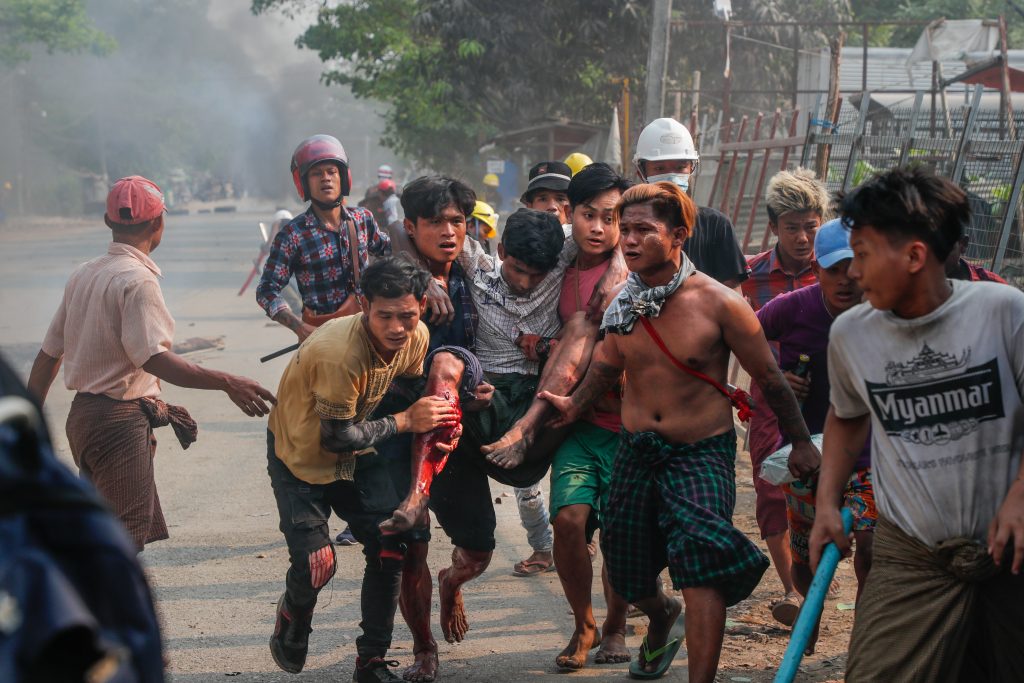
Protesters carry a man hit in the leg by a live round. (Frontier) 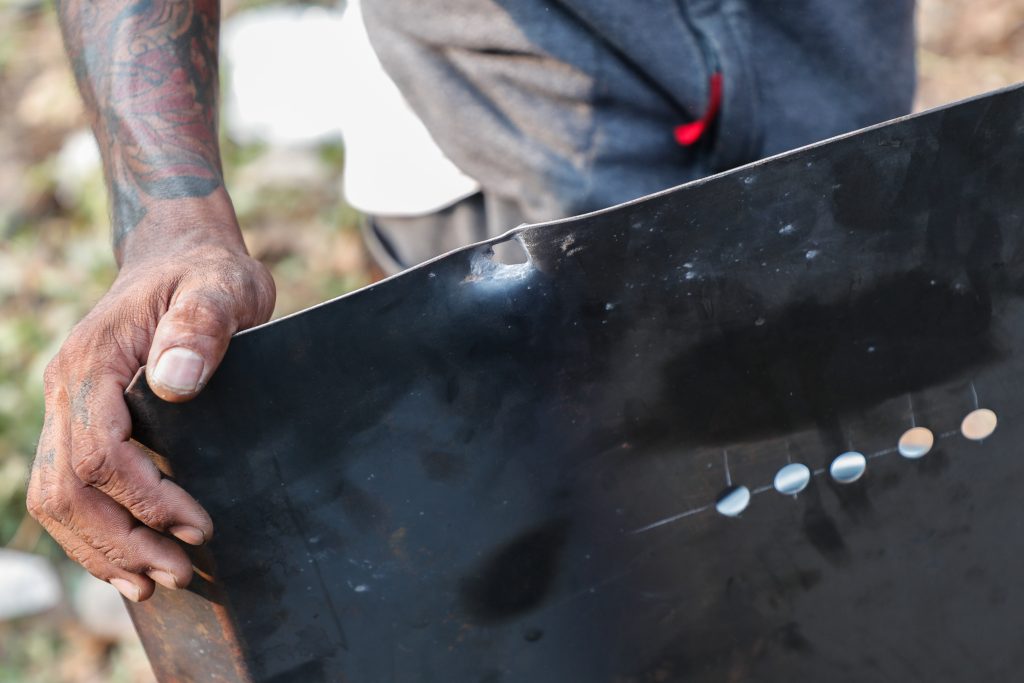
A bullet hole in a home-made shield. (Frontier) 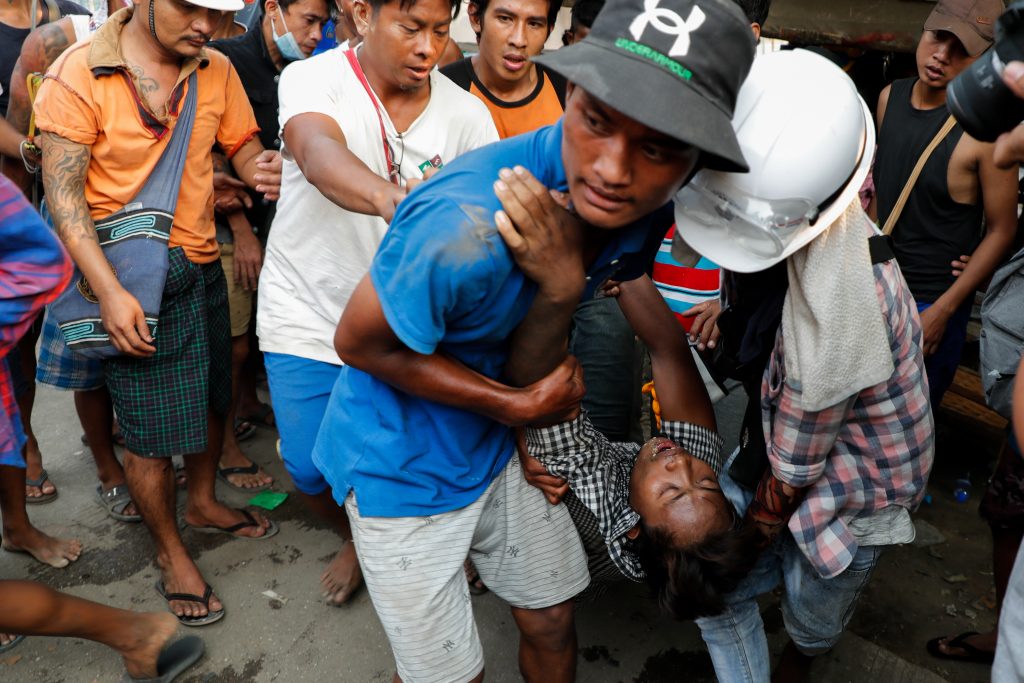
Residents carry an injured man. (Frontier)
As I took a photo, somebody grabbed me by my backpack and pulled me back into the house. Everyone was quiet; they’d even switched off the electricity. We were all aware of what the security forces might do if they found us. But the effects of the tear gas meant I couldn’t breathe properly or see anything, so I ran to the bathroom at the rear of the house, trying to be as quiet as I could. I threw water on my face and covered my eyes with my scarf.
We jumped through a window and managed to reach a workers’ hostel. I could still hear gunshots nearby, so I searched for a place to hide on the upper floor. Luckily, one of the seven hostel rooms was unlocked, so I and a photographers and a videographer took refuge. From the window, we peered outside. We couldn’t see anything, but there was the sound of continuous gunshots and shouting.
We decided to try and get to a higher point to see what was happening on the ground. We managed to reach another building at the back of the hostel and climbed onto its rooftop, where we saw clouds of black smoke filling the sky on the eastern side of Tabinshweti Road – also known as Kanaung Minthargyi Road – home to many factories. With blood having been spilled, I immediately assumed that protesters were making good on their retaliatory promise to burn factories.
We heard more shooting just a few blocks away, so we left the building and ran further from the main road. After re-grouping with two other photographers, we tried to get our bearings. A resident pointed us towards Tabinshweti Road, and said protesters and soldiers were facing off there.
A pile of tires was on fire in the middle of the Tabinshweti Road. On one side were soldiers and police and on the other were protesters behind a sandbag barricade. They were barely 20 metres apart. A resident said there was another group of soldiers and police further back, but we couldn’t see them through the smoke and haze.
Suddenly, a resident asked us distrustfully who we worked for. We told him, but he accused us of being aligned with the military. “We don’t believe you. Don’t take photos of us,” the man said. But others began pleading with him to let us do our job, and eventually he left us alone.
Shortly after, a few people – maybe 15 in total – with homemade shields began to approach the police and soldiers from behind, apparently preparing to attack them. Police fired at the approaching group and hit a man in the leg. They group retreated, carrying him to a motorcycle trishaw, and from there he was sent to a nearby clinic.
I took out my telephoto lens to get a better view of what lay ahead. Beyond the line of soldiers, I saw two snipers aiming right at us.
Another group of protesters advanced, and again the security forces fired. A man who had been hit in the abdomen was brought back to safety, but his injury looked serious; he’d already passed out and vomited on his shirt. He too was bundled into a nearby motorcycle trishaw and carted off.
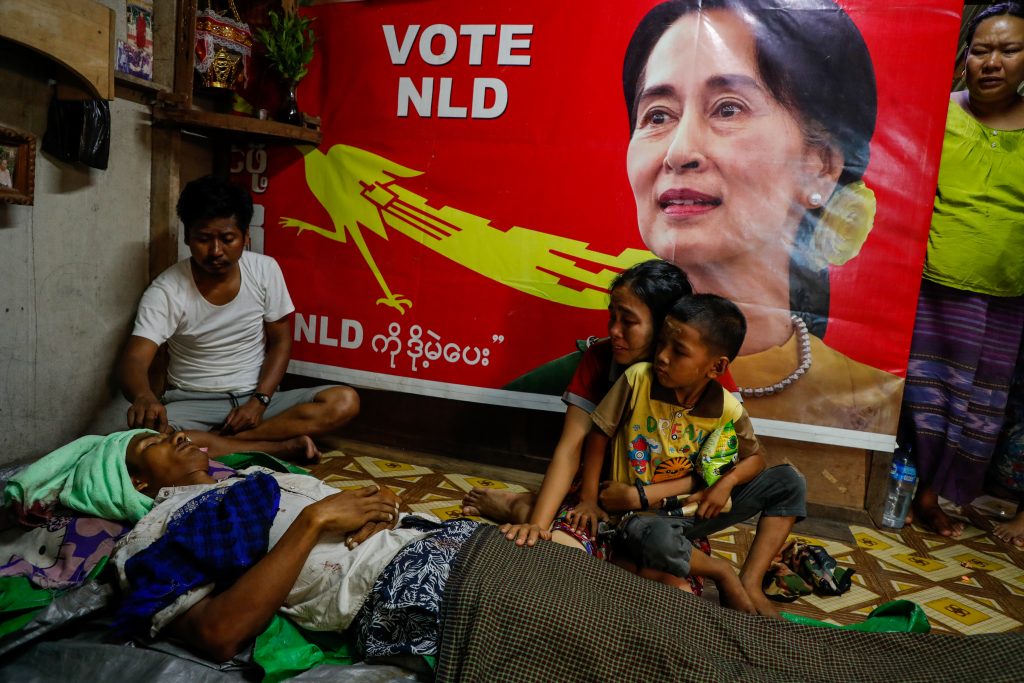
Others did not escape with just injuries. A short time later, we entered the nearby home of Ko Thet Wai, 35, who had been killed by a shot to the head that morning. His wife, Ma Zin Mar Win, and their six-year-old son were sobbing beside his body, which was laid out on the living room floor. The wall behind the body was dominated by a large vinyl poster of Daw Aung San Suu Kyi and the flag of her party, the National League for Democracy. The small home was packed with people in clear distress. It was a powerful scene, but it felt like we were intruding. We didn’t stay long.
When we returned to Tabinshweti Road, the protesters were still manning barricades, advancing every now and then on the security forces. These advances seemed like suicide missions to me. I couldn’t work out the strategy – what were they trying to do? Were they trying to attack the police and soldiers? Or were they trying to distract them? Perhaps it was the latter – sometimes the security forces would turn their backs and start firing into the residential areas off to the side, at which point a group of young men would yell and charge. Either way, it seemed incredibly dangerous and reckless – the protesters had flimsy shields and were facing live rounds. Sometimes they retreated without any injuries.
We decided to return to Hlaing River Road, where we had started the day. The scene was entirely different; there were fires everywhere on the road, where barricades and tires had been set alight, and everything was quiet.
We headed further west along Hlaing River Road to Mee Kwet Market. It looked like an abandoned battlefield. Soldiers stared at us from the road, where a line of military trucks was parked. There were no protests. The burning car tires made the air gloomy and menacing.
At 6pm, protesters and soldiers faced off on Bogyoke Aung San Road, which runs north-south through Hlaing Tharyar. At the bottom of the Aung Zeya Bridge I saw eight military trucks. Residents holding shields began moving towards the soldiers, who began shooting at them.
As darkness started to descend, we decided it was time to get back across the river to Yangon. We planned to take my friend’s car across the northernmost bridge to Shwe Pyi Thar. We left Bogyoke Aung San Road, zig-zagging around the sandbag barricades. Residents were manning some of them and had set up removable gates; when we arrived at one, we told them we were photojournalists trying to get back to Yangon and they let us through. Looking back towards Hlaing Tharyar, I could see more factories on fire close to Tabinshweti Road. Thick black clouds of smoke filled the sky.
When we reached the next gate – before we could take any photos of the fires – a man approached and laid his sword on the bonnet of the car threateningly, warning us not to get our cameras out. We quickly promised that we wouldn’t. When we asked to be allowed through, one of the residents told us that the Shwe Pyi Thar Bridge was closed. “I don’t know if you can go back, but if you come back here, we won’t open the gate again,” they said.
Rather than risk it, we decided to go back and sleep at a friend’s house in Hlaing Tharyar. On the way, we spotted an injured man being transported in a motorcycle trishaw. We got out of the car and tried to follow the trishaw through the back streets. With the help of residents, we eventually found the clinic – one of the few that were treating injured protesters – but the staff there said the man had died shortly after arriving, and the trishaw driver had taken him away. We emerged onto the road to see the body still in the motorcycle trishaw. The driver was asking people to look at the man and help identify him. “We don’t know who he is or where he came from,” he said, as people gathered around.
At about 8:30pm, we finally arrived at the house. It was a long, quiet and entirely sleepless night. The announcement of martial law in Hlaing Tharyar had left me terrified. At around midnight, the residents providing security in the ward had shouted to everyone to turn their lights off, as police were approaching. We lay in the darkness until the threat passed.
At 8am we decided to try and go back to Yangon. It wasn’t easy getting to Bayintnaung Bridge; many roads were blocked with bamboo sheets and sandbags. Luckily, we found an open path and managed to cross the bridge. Entering Yangon, we saw fires had been set underneath and beside the bridge, and stopped to take photos. Suddenly, three people emerged and pulled back their slingshots, poised to fire. “Don’t you dare take photos of that,” they shouted. I tried to speak to one of the men, but he wouldn’t let me explain, so I hurried back to the car.
Most of the time I’ve been covering the protests I’ve felt welcome among the demonstrators. They understand the role of the media in telling their story to the world. In contrast, if the police or soldiers see us trying to take their photos, they usually try to arrest us.
Hlaing Tharyar felt different. To the protesters there, anyone from outside their community was a potential threat, including the media. You had to work much harder to build a rapport with them, to build trust. Some clearly just didn’t see any benefit in us documenting what was going on.
I later learned that dozens of people had been killed that day – some sources put the number as high as 54. Although I hadn’t seen them die, I wasn’t surprised. From the minute security forces first attacked, it felt as though the gunfire never stopped. I knew from my experience that at least some of the gunshots were live rounds.
But the way the protests unfolded was also different. Elsewhere in Yangon, the protesters don’t confront security forces the same way; when the police crack down with tear gas and rubber bullets, they run into nearby buildings and wait. In Hlaing Tharyar, some demonstrators displayed a reckless bravery, confronting security forces armed with automatic weapons. It wasn’t a fair fight, and it didn’t matter how tough or determined they were. All it took was one live round to stop too many of them dead.


